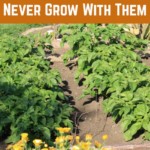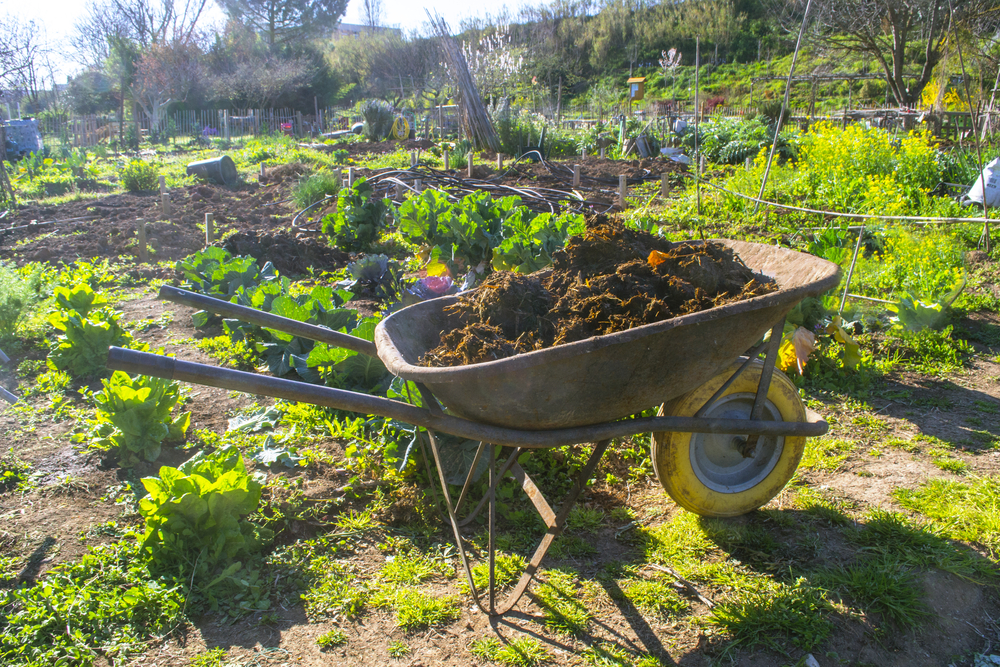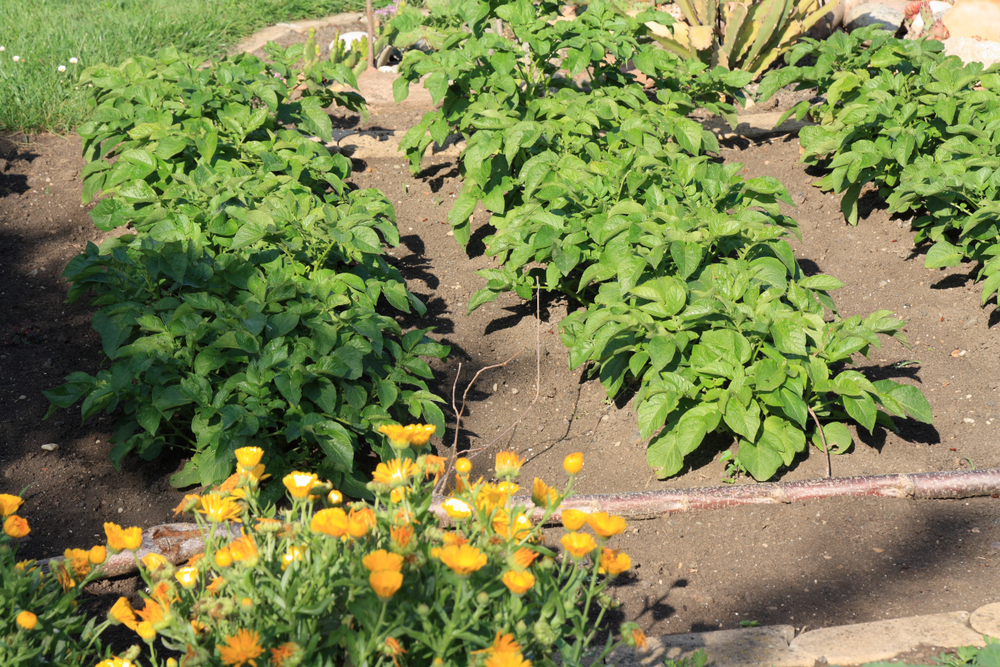
Potatoes are a staple crop on many temperate climate homesteads. Potatoes are generally a relatively easy (though space consuming) crop to grow.
Get it right when it comes to choosing and growing potatoes and you can enjoy your own home grown potatoes all year round – especially if you learn how to store them for many months.
As you will find out in this article, there are a number of ways to boost your potato harvest – but choosing the right companion plants is our number one tip.
Top Tips To Boost Your Potato Harvest
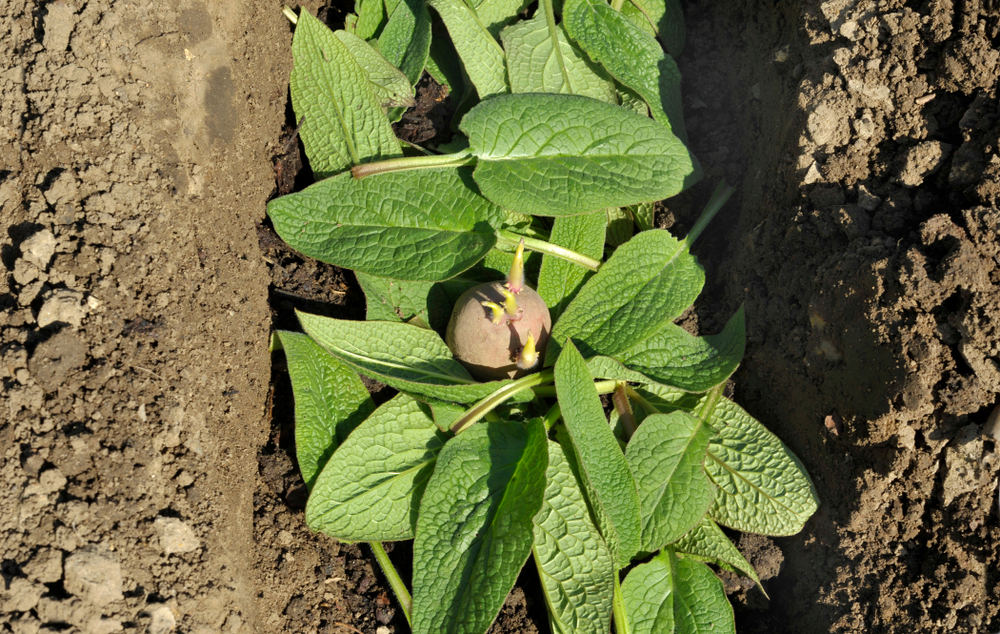
We have plenty of tips when it comes to getting the most from your potato harvest. General tips for a good potato harvest include:
- Choose the right varieties for your location and needs, and source seed potatoes from a reputable source.
- Chit potatoes to give them a good head start.
- Consider growing first early potatoes under cover early in the year for an earlier potato harvest. (And perhaps even an additional under-cover sowing later in summer for a Christmas harvest of small new potatoes.)
- Plant potatoes with comfrey leaves (or fertilize with a liquid comfrey fertilizer) at planting time.
- Earth up potatoes with high quality compost and mulch well with organic matter (such as seaweed, comfrey leaves etc..)
But perhaps the best way to boost your potato yield this year is to stop growing potatoes in their own, separate bed.
Instead, choose companion plants for potatoes, to create polycultures or guilds around them to help them grow strong.
To find out more about companion plants and why we use them, check out my article on companion plants for tomatoes. In that article, you’ll find out more about how and why we use companion plants and create polycultures in an organic garden.
But which companion plants should you choose to grow alongside your potatoes?
Read on for some suggestions.
Vegetables to Plant Alongside Potatoes
First of all, let’s take a look at some of the other annual vegetables (and legumes) that could be grown alongside your potatoes:
1. Horseradish
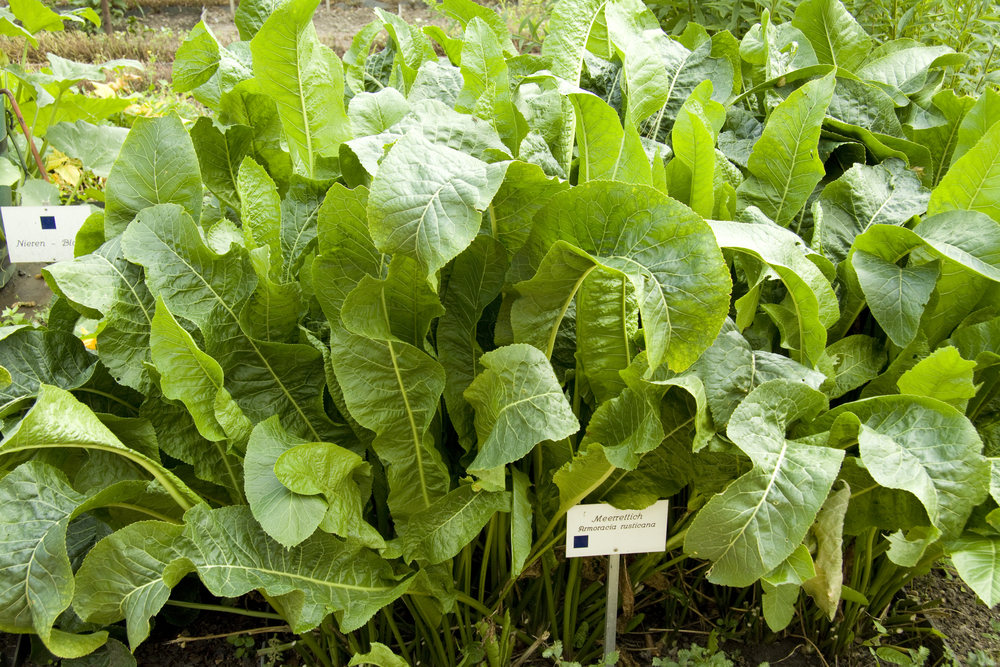
Horseradish is a perennial root vegetable grown for its fiery flavour. But another reason to grow it is to give potatoes a helping hand.
Horseradish grown around the edges of your potato growing area is said to increase the disease resistance of your potato plants.
It is also believed to repel the potato bug, potato beetles, aphids, whiteflies and some caterpillars.
While these claims have little scientific backing, there is a wealth of anecdotal evidence from gardeners and growers who swear to its efficacy.
There is also some evidence to suggest that incorporating the organic material from horseradish plants into the soil around potatoes can, in certain circumstances, have pest controlling characteristics.
It is the compound allyl isothiocyanate found in the plant which is said to have pest repelling properties. (It is also this oil which gives the plant its peppery taste.)
(Note, however, that horseradish is a member of the brassica plant family and can harbor common brassica pests, so should not be grown close to cabbages, kale, broccoli or other members of this plant family.)
2. Garlic
Planting garlic around the potato bed may also be efficacious in repelling certain pests.
The pungent aroma of the garlic is said to repel certain species, and to confuse or distract others, making the primary plants in the bed more difficult for pests to find.
Intercropping potatoes with garlic was also found to be more effective than fungicidal treatments for the control of late blight in this study.
3. Onions
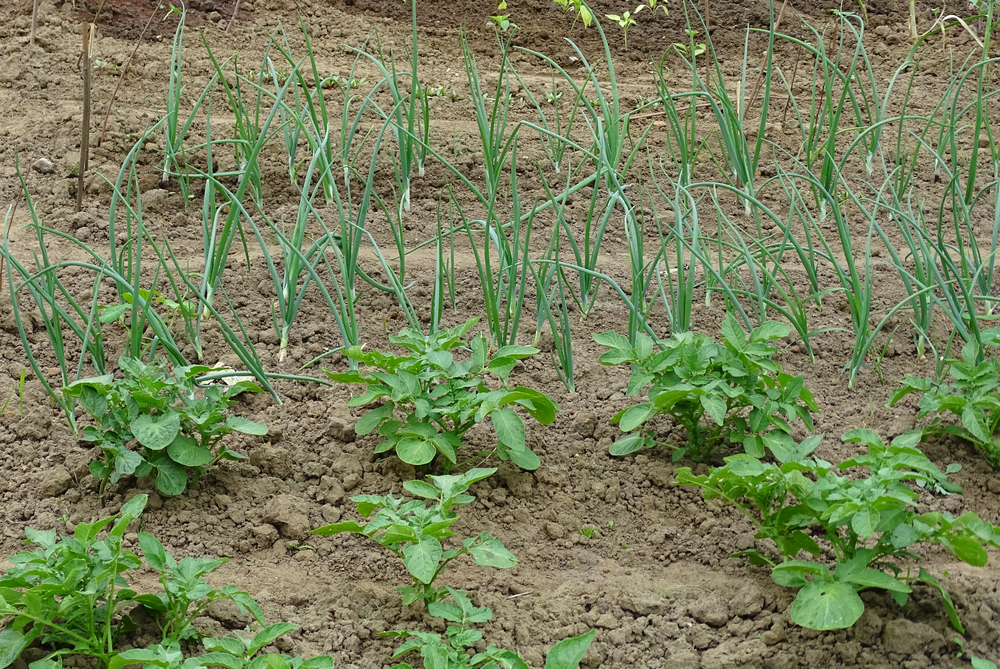
Onions have also been found to be efficacious against certain insects when intercropped with potatoes in certain studies.
Again, the strong smell of this allium may help to reduce insect damage on your potato plants.
4. Scallions/ Green Onions/ Spring Onions
Scallions, green onions or spring onions are an allium that could be particularly useful for growing alongside potatoes in a home setting, because they are small and can easily be incorporated between rows of potatoes being earthed up in a traditional way, and along the edges of growing areas.
Note, however, that alliums are believed to suppress the growth of legumes such as peas and beans.
So while, as you will see below, alliums and legumes can both be potentially beneficial for potatoes, both should not be included in the same polyculture.
5. Peas
Peas are a nitrogen fixing legume, and as such, may be helpful to potatoes, which have relatively high nitrogen needs.
Studies have suggested that yield on a certain area of land can be increased by intercropping of these two plants.
In a warm climate, during hot summer weather, pea crops planted to provide shade to potatoes may also have a benefit, since the increased shade will reduce moisture loss from the soil and aid the potato crop, which requires relatively high levels of water.
Peas have also been shown to reduce the incidence of Colorado potato beetles.
6. Beans
Beans may also provide similar benefits to potatoes as peas. Both as a nitrogen fixing plant, and as a shade provider.
Studies into intercropping of beans and potatoes have shown that in certain circumstances, overall yield can be increased on a given area of land by planting the two together.
7. Corn
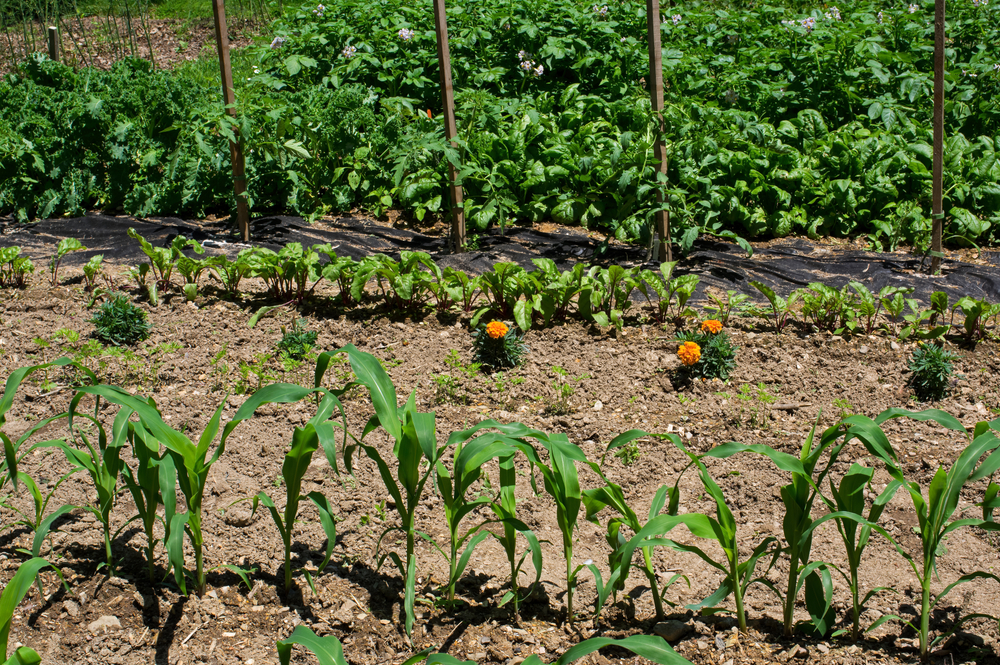
In a warm climate, growing corn on the sunny southern side of your potatoes could also bring benefits through providing shade for this cool climate crop.
The shade will help reduce water evaporation from the soil, which can help make sure potatoes have enough water and will grow well and taste good upon harvest.
8. Lettuce
Finally, it is also worthwhile considering crops that, while they may not help the potatoes themselves, will help increase the yield on your property without affecting your potato crop.
Lettuce is one shallow-rooted, fast growing crop that can be sown between potatoes. It grows fast enough that it can be harvested before competition becomes an issue.
9. Spinach
Spinach is another example of a leafy green with shallow roots that can be sown around your potatoes early in the season.
Sowing lettuce, spinach and other similar leafy greens will help you to make the most of the space you have available.
Another benefit of sowing leafy greens like lettuce and spinach around young potato plants is that they can help to create good ground cover, which is another way to reduce moisture loss.
It can also help to reduce the incidence of weeds that may compete for nutrients with your potato plants.
10. Radishes
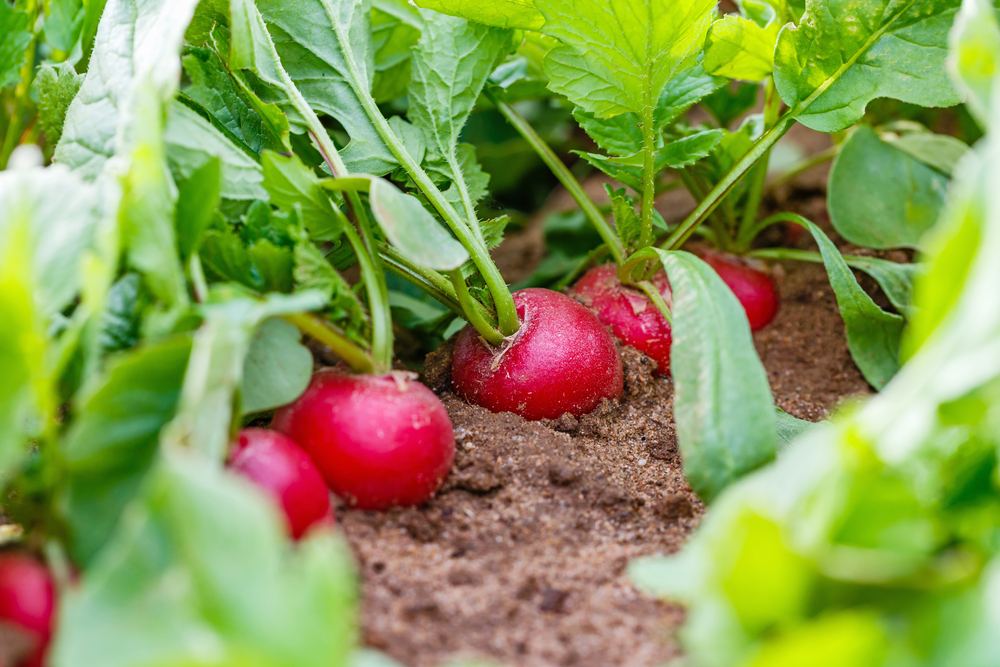
Radishes are another great space-filling crop. These too have relatively shallow roots and are fast-growing.
So again, you can enjoy a harvest from between your potato plants before they grow to fill the space and require the room and nutrients available.
Radishes can also help the potatoes and the leafy greens planted alongside them by repelling flea beetles.
Herbs That Make Good Companion Plants for Potatoes
It is important to think about vegetables and legumes that could be sown and grown alongside potatoes.
As mentioned above, these can aid the potatoes and make the most of the space available. But it is also a great idea to think about adding aromatic herbs around your potato plants.
Some aromatic herbs that could make good companions for potatoes include:
11. Thyme
Thyme is a good companion for potatoes on the plate, but also in the garden.
Primarily, thyme is a good companion for potatoes because it is particularly good at attracting hoverflies/ Syrphidae which reduce aphid numbers through predation.
It can also spread to create good ground cover.
Thyme likes much drier conditions than potatoes, but could work well elevated on the southern side of potato mounds, for example, where it can enjoy the sunnier and drier conditions it needs.
Even better, harvest some thyme leaves ad sprinkle on your roast potatoes for a delicious flavor combo.
12. Yarrow
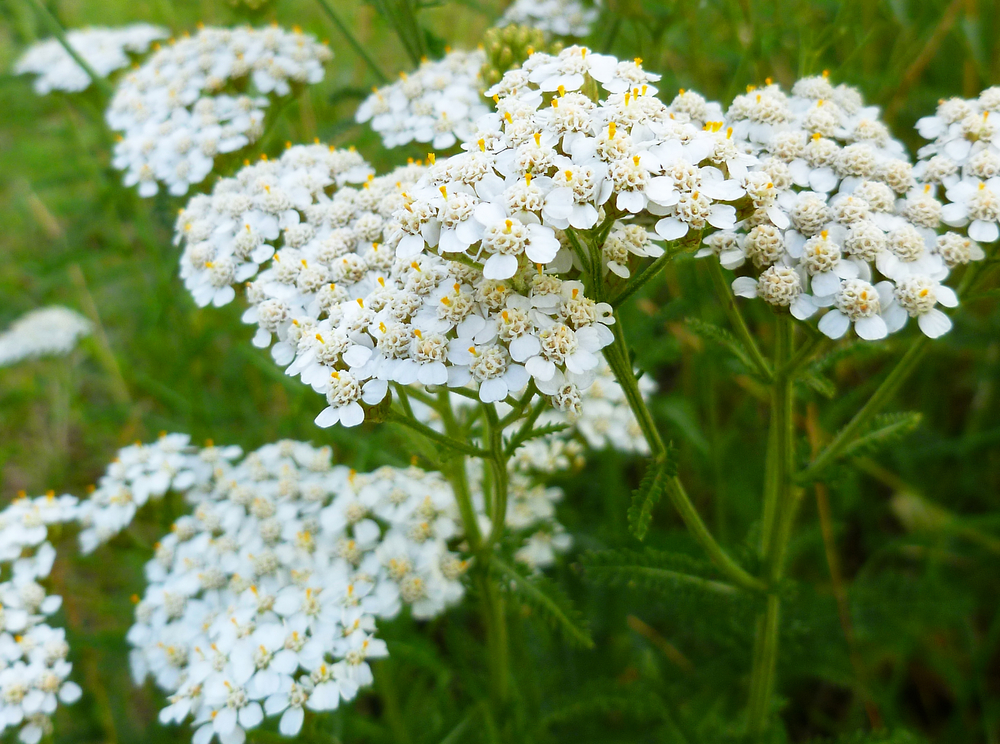
This is another perennial herb that can work very well as a companion plant to many other crops.
Yarrow also attracts a range of beneficial insects, and its deep roots mean that it can be an effective dynamic accumulator. When later chopped and dropped around potato plants, it can help to deliver the nutrients they need.
Yarrow helps break up the soil, and potatoes can benefit from this.
They do best in soil that is not too compacted. Yarrow grown as a companion alongside other aromatic herbs can also help increase their essential oil production, which can boost their pest-repelling or confusing properties.
13. Chamomile
Grown alongside other companion herbs, chamomile also increases their oil production. It also attracts a range of beneficial insects, including hoverflies and predatory wasps.
14. Basil
Basil is a herb that can do well when grown alongside potatoes. It can thrive in the somewhat moist environment beneath your more mature potato plants.
It repels certain common pests, including thrips, flies and hornworms.
15. Parsley
Parsley is another herb that enjoys the moist soil around potato plants.
It attracts certain beneficial insects, and acts as a trap crop for insects that feed on potato plants (as well as tomato plants and other members of the same family).
16. Sage
Sage is another aromatic herb that helps vegetables by attracting honeybees and other pollinators, and may also help potatoes by keeping flea beetles away.
17. Catmint
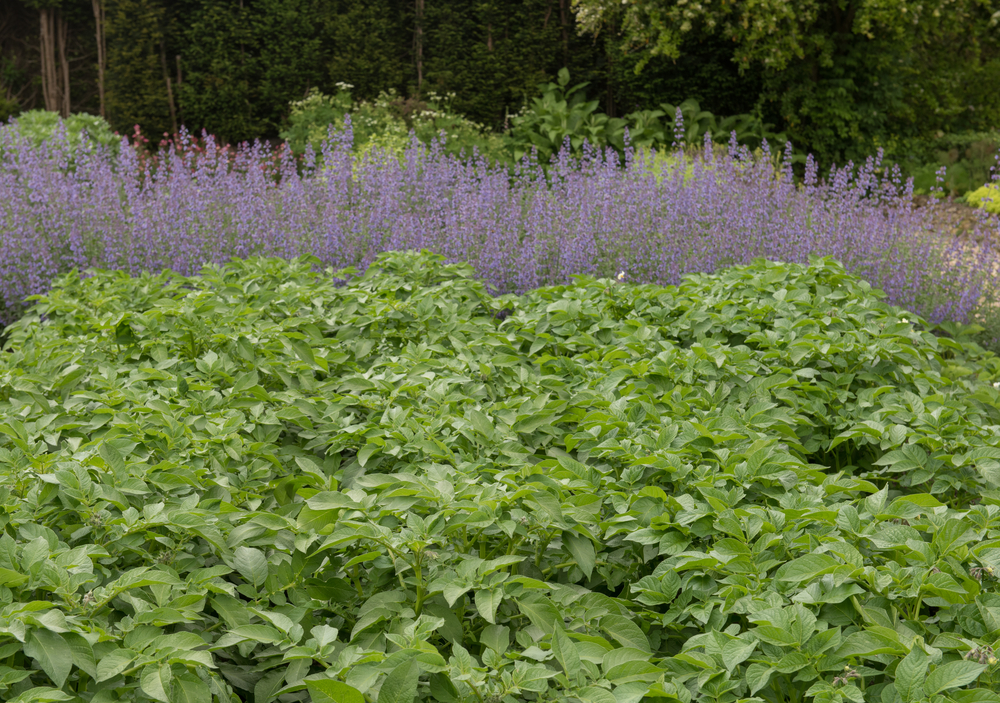
Catmint also has deterrent properties for certain pests. Some gardeners swear that catmint is one plant that can help to deter potato beetles, for example.
18. Tansy
Tansy is another herb that may help keep potato beetles at bay. Again, this is a herb that can also attract certain beneficial wildlife.
19. Cilantro
Likewise, cilantro is another crop to plant in a fight against potato beetles. Cilantro also attracts hoverflies which can aid in reducing pest populations.
20. Lovage
Lovage improves the health of almost all plants grown nearby as a companion plant.
It is also especially good at attracting beneficial insects such as bees and other pollinators, as well as certain wasps and beetles.
Flowers That Make Good Companion Plants for Potatoes
Finally, it is also a good idea to think about the flowers that it is beneficial to grow alongside potatoes. Flowers that can be great companions for potatoes include:
21. Marigolds
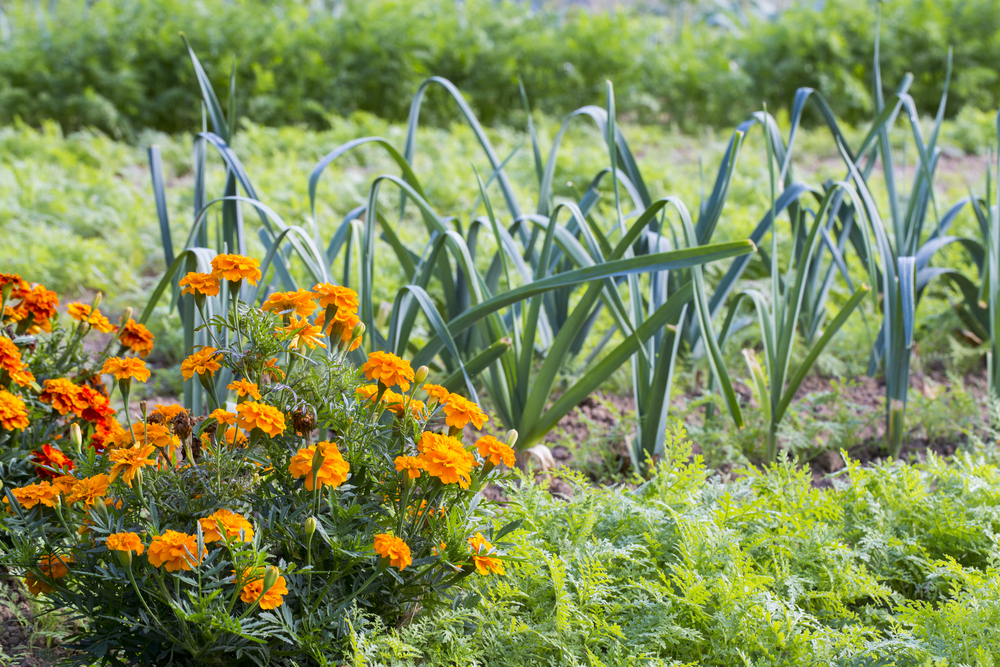
Marigolds are an important companion plant that are beneficial when planted throughout your garden.
Check out this article on growing marigolds in the vegetable garden to find out more about this wonderful flower and the many reasons to grow it in your garden.
22. Calendula
Calendula (also called pot marigold) should not be confused with the above. But this too can be a useful companion plant.
Largely for its wildlife attracting properties, calendula can also be a great choice for potato polycultures.
23. Nasturtiums
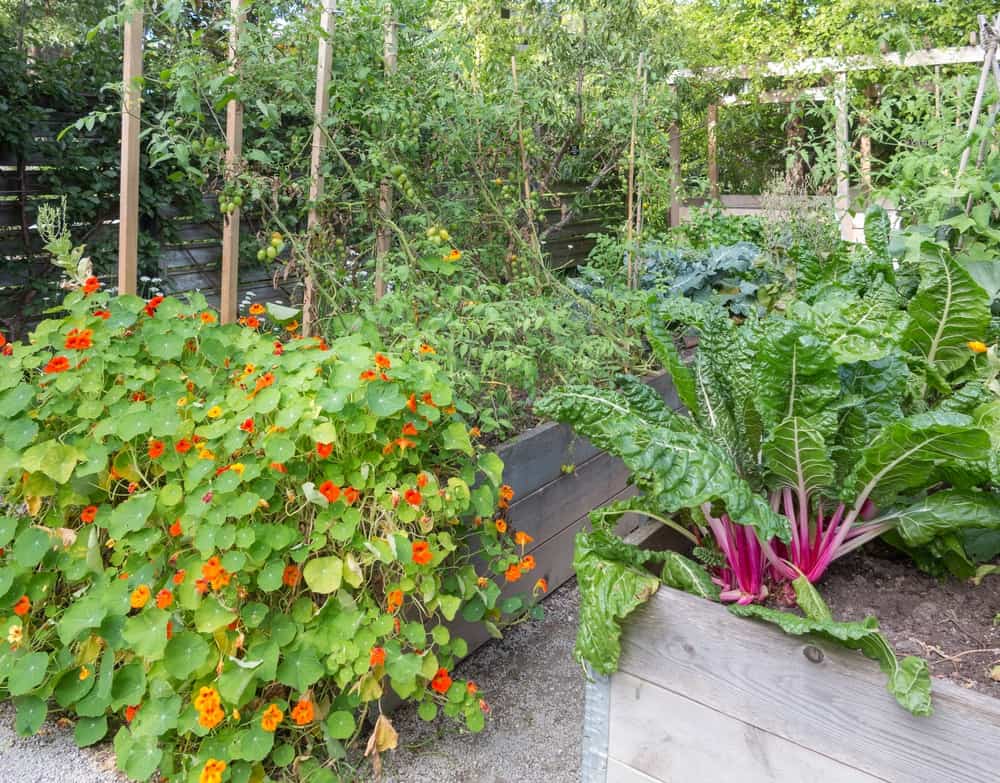
Nasturtiums are another multi-purpose companion plant that you can use as a good companion for a range of commonly cultivated fruits and vegetables.
More commonly, you will use them as companions for cucurbits such as cucumbers and squash, or other summer crops like tomatoes.
But the same reasons that make them good companions for these plants also make them good companions for potatoes.
Check out my article on reasons to grow nasturtiums in your garden to find out more.
24. Borage
Borage is another flowering plant that you should consider sowing and growing throughout your garden.
It can be beneficial in a forest garden or fruit tree guild, or in an annual vegetable plot.
Around your potatoes, it can help as a dynamic accumulator, and can help maintain fertility and retain moisture for your crop when chopped and dropped.
It can also help by attracting a range of beneficial insects when in flower.
Here’s a lot more reasons why you should grow borage.
25. Petunias
These pungent, sweet smelling flowers may protect potatoes from certain pests such as leafhoppers.
26. Alyssum
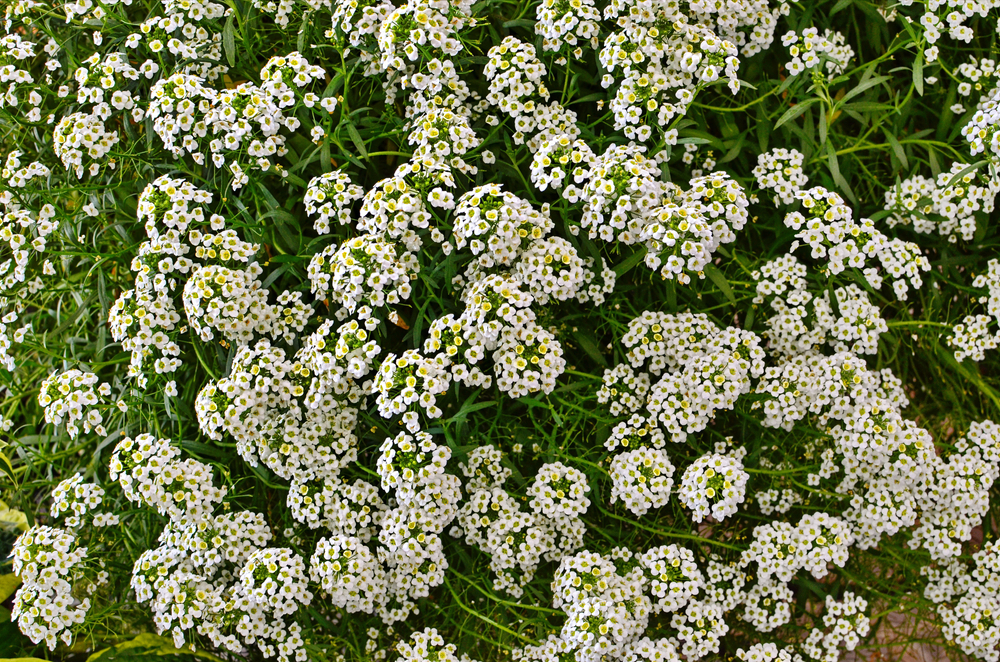
Alyssum can create excellent ground cover around your potato plants.
These flowers not only look pretty, and help retain soil moisture, they are also excellent at attracting predatory wasps that eat insect pests that might plague your potatoes.
27. Clover
Clover, like peas and beans, is a nitrogen fixing plant. It can also help potatoes by providing good ground cover around the plants during the warmth of summer.
When in flower, both white and red clover varieties attract pollinators but also a range of other beneficial insects.
28. Vetch
Vetch is another nitrogen fixing plant and, again, you can intercrop it with potatoes or use it to create good ground cover.
Again, this can help to reduce soil moisture loss and reduce can also help to reduce the incidence of weeds.
29. Dead Nettle
Some weeds, however, can be a good thing, and this is well worth remembering.
One weed that can be beneficial to potatoes is dead nettle (lamium).
Dead nettles may improve the taste and vigour of potato plants growing nearby and might also help in repelling certain pests.
30. Flax
Finally, flax may improve potato plants’ growth and flavour. It may also deter potato bugs.
8 Plants To Avoid Planting Near Potatoes
What you avoid planting near potatoes can be just as important as what you do grow near them.
Here are some of the plants which do not make good companions for your potato plants:
1. Brassicas
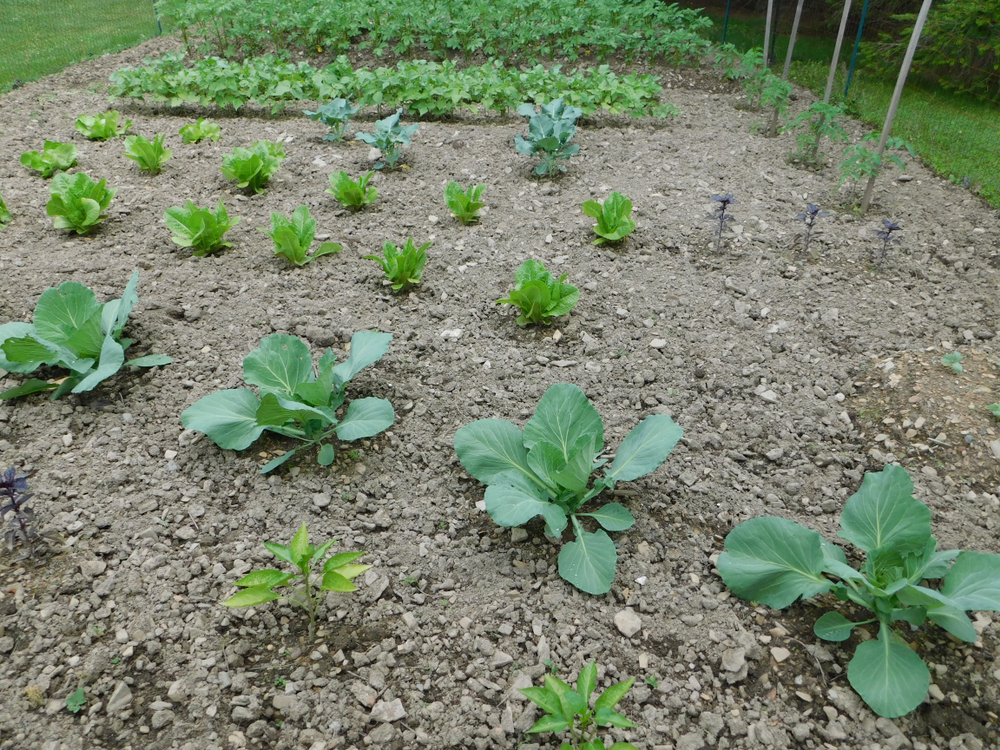
Since horseradish is such a good companion for potatoes, many other brassicas (members of the cabbage family) are often recommended for growth alongside them.
But while this plant family is often recommended for growth alongside potatoes, it is not really a good idea.
The primary reason why it is not a good idea to include brassicas and potatoes in the same growing area is that they do not enjoy the same conditions.
While they do have similar water and nutrient needs, brassicas will do best in a somewhat more alkaline environment.
Potatoes, on the other hand, grow best in slightly acidic soil.
The mulches you choose for these plants can be used to influence this factor, and help to prevent problems such as root knot in brassicas and scab in potatoes.
When you grow them together, the different needs will be much harder to meet.
2. Tomatoes (And Other Members of the Nightshade Family)
Potatoes are part of the same plant family as tomatoes, peppers and aubergines.
The problem will growing potatoes close to or with other members of this family is that pests and diseases spread easily between them.
Don’t grow them together, or plant them in the same bed following one another. Try to keep a good crop rotation system in play when it comes to this plant family.
3. Cucumbers and Squash
It is also a good idea to keep cucumbers, squash and other members of the cucurbit family away from your potatoes, since these can make your potatoes more susceptible to blight.
These are also, like potatoes, ‘hungry’ plants, and can compete with the potato plants for water and nutrients.
4. Raspberries
Keep raspberries well away from your potato plants too. Since these too can increase the chances of a problem with blight and other potato diseases.
5. Carrots
Carrots are another crop that are not beneficial close to potatoes.
For one thing, the carrots and potatoes do not share the same environmental needs. Carrots can cope with far drier conditions than potatoes.
Carrots may also stunt the growth and development of potato tubers.
But mostly, the problem is that the disruption involved in harvesting potatoes can damage and disrupt the carrot crop nearby. (The same goes for several other root crops.)
6. Asparagus

Growing asparagus in the same bed as potatoes is also a no-go.
Some say that the asparagus will compete with the potatoes and stunt their growth and development.
But the main issue is that asparagus, as a perennial crop, has an extensive root formation that will be damaged by the earth movement required in potato growing and harvesting.
7. Sunflowers
Sunflowers can have allelopathic effect, which means they excrete chemicals which can inhibit seed germination and stunt the growth of certain other crops grown close by.
Growing sunflowers near potatoes may result in smaller and misshapen potato tubers.
So while sunflowers can be great companions for corn and other crops – keep them away from your potatoes.
8. Fennel
Finally, fennel is another allelopathic plant. It can stunt the growth of a wide range of commonly cultivated crops.
So you should keep fennel away from other plants that are affected by the chemicals it excretes.
Place it where it can attract beneficial insects without having a detrimental effect.
Examples of Potato Polycultures
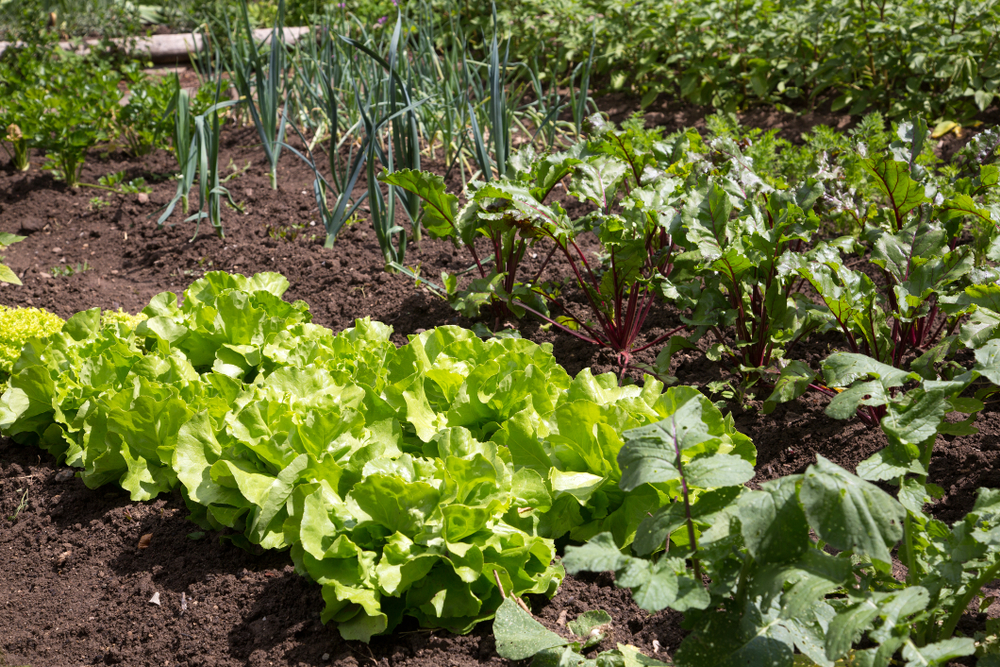
It is important to remember, when planning your garden, that companion planting is by no means an exact science.
A huge range of factors contribute to the interactions between plants.
Where you live will have an influence on which combinations work well, so experimentation is definitely in order.
In order to further help you to come up with successful guilds in your garden, here are examples of the potato polycultures that work well for me where I live:
I plant potatoes in my polytunnel early in the spring. Soon after the potato plants emerge, I companion plant with:
- lettuce and other spring greens
- radishes
- spring onions
All of which will be harvested before the potatoes grow to fill the space. I also place marigolds along the edge of the bed as soon as the weather warms sufficiently.
These remain in place after the potatoes have been harvested, when the potatoes are replaced by summer beans and more leafy salad crops.
I also grow potatoes outdoors. I plant these a little later in the spring alongside:
- fava beans
- green peas
- horseradish
- borage
- and a range of aromatic herbs (e.g. parsley) around the edges of the bed.
Once the potatoes are ready for harvest, the peas and beans are chopped, leaving the roots in place. And the borage is chopped and dropped.
I add additional mulch to the zone, ready for the next phase of planting.
Of course, these are just examples of what I have found works well for me.
Be sure to experiment with plant combinations to see which work best for you, where you live.
But remember, integration is always better than segregation when it comes to the plants that you grow.
Read Next:

Get the famous Rural Sprout newsletter delivered to your inbox.
Join the 50,000+ gardeners who get timely gardening tutorials, tips and tasks delivered direct to their inbox.


